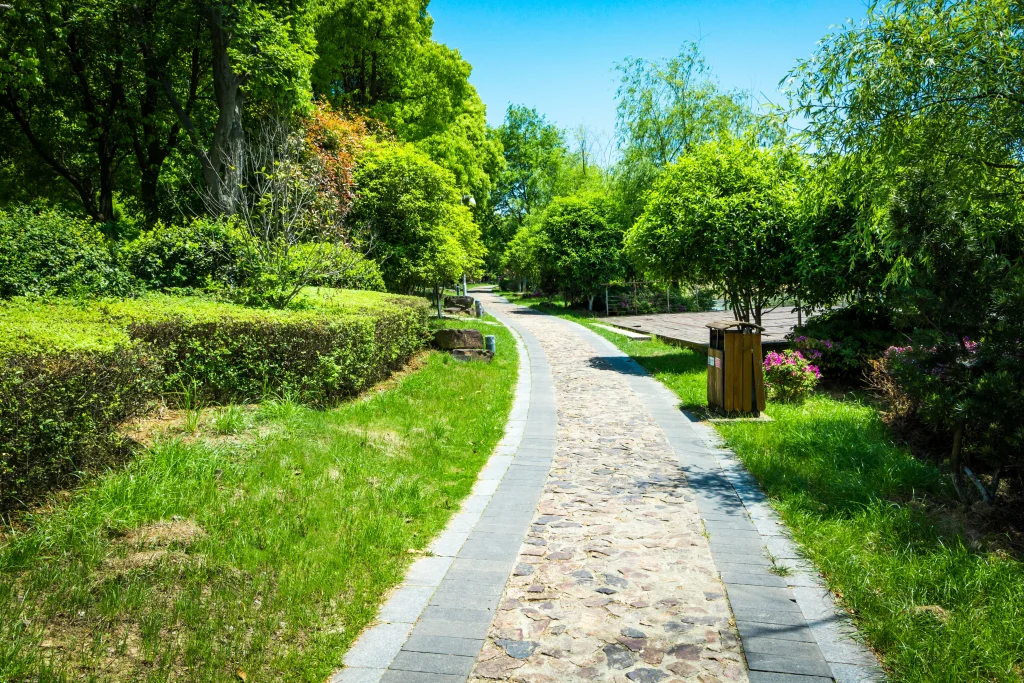How to keep dogs out of flower beds and gardens? To effectively do this, you can build raised flower beds using physical barriers like chicken wire or bamboo fencing, combined with natural deterrents such as citrus peels or cayenne pepper. This dual approach creates effective boundaries while protecting both plants and pets.
At Mile High Lifescape, we understand this struggle. Denver’s thin air and intense sunlight already stress flower beds. Add enthusiastic dogs to the equation, and gardening becomes even more challenging. Many homeowners feel torn between their garden dreams and their furry family members.
This guide presents 8 practical, humane solutions that protect flower beds without harming or stressing dogs. These methods work specifically well in Colorado’s unique climate and respect the special bond between Denver residents and their pets.
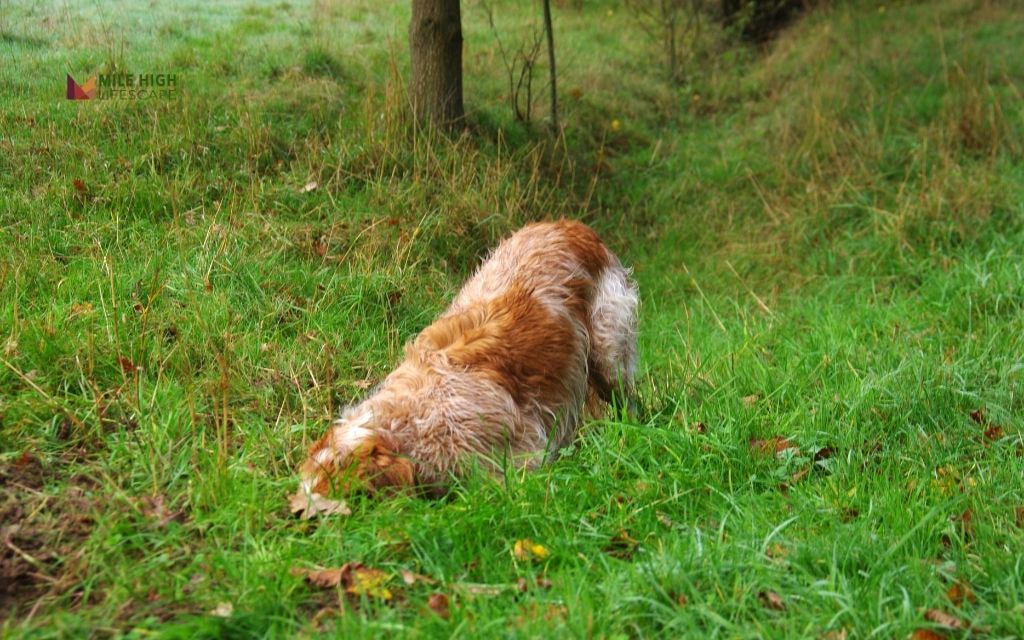
Why Do Dogs Get Into Flower Beds?
- Digging instinct drives many intrusions. Cool, moist soil provides relief from Denver’s intense sun. Dogs instinctively seek comfortable spots, and freshly watered flower beds offer perfect refuge. Underground critters like grubs and beetles also attract hunting-minded pets.
- Territory marking represents another common cause. Dogs naturally claim spaces through scent, and flower beds often sit along property boundaries where territorial instincts run strongest.
- Chase behavior leads dogs through gardens pursuing squirrels, birds, and insects. Denver’s abundant wildlife creates constant temptation for active pets. Movement triggers prey drive, sending dogs racing through carefully planted spaces.
- Lack of boundaries confuses pets about acceptable areas. Without clear signals, dogs assume all yard space belongs to them. This confusion increases when homeowners inconsistently enforce garden rules.
- Boredom and attention-seeking also drive unwanted garden behavior. Understimulated dogs create their own entertainment, often at flower beds’ expense.
Denver Tip: Local dogs show heightened sensitivity to dry soil and thin air. Cool, soft garden beds become even more attractive during hot summer afternoons when concrete and hardscape surfaces become uncomfortably warm.
How to Keep Dogs Out of Flower Beds: 8 Effective Solutions
#1: Physical Barriers: Fencing & Edging
Physical barriers provide immediate, reliable protection for flower beds. Low-profile garden fencing stands 18-24 inches high, effectively deterring most dogs without blocking garden views.
Decorative metal borders add aesthetic appeal while creating clear boundaries. Wood edging works well for rustic garden styles and integrates naturally with Denver’s outdoor living trends. These materials withstand Colorado’s temperature extremes and UV exposure.
Temporary garden fencing suits puppies or smaller breeds that may outgrow digging habits. Flexible mesh barriers adapt to irregular bed shapes and curved garden designs. These solutions work particularly well around new plantings that need protection during establishment.
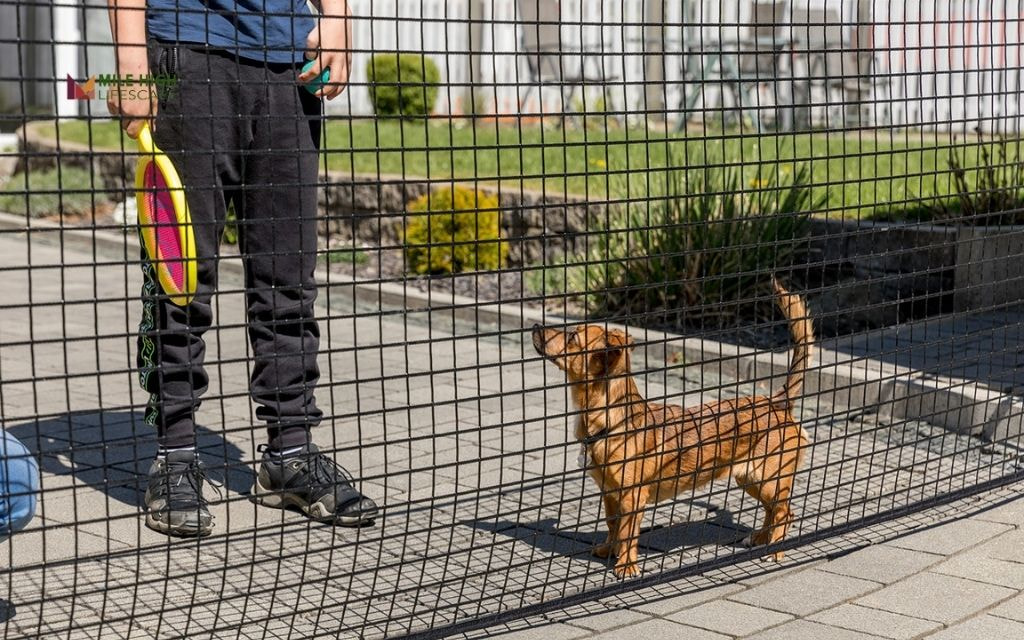
#2: Create Defined Dog Paths and Play Zones
Strategic landscape design redirects dog traffic away from sensitive flower beds. Designated areas with pea gravel, mulch, or artificial turf satisfy dogs’ need for defined pathways.
Dogs naturally prefer clear, durable surfaces over loose soil. Well-designed paths guide pets around gardens while providing comfortable walking areas. These zones reduce random garden intrusions by offering attractive alternatives.
Training dogs to use designated zones requires consistent reinforcement. Reward pets with treats when they choose appropriate areas. Combine path creation with positive training for best long-term results.
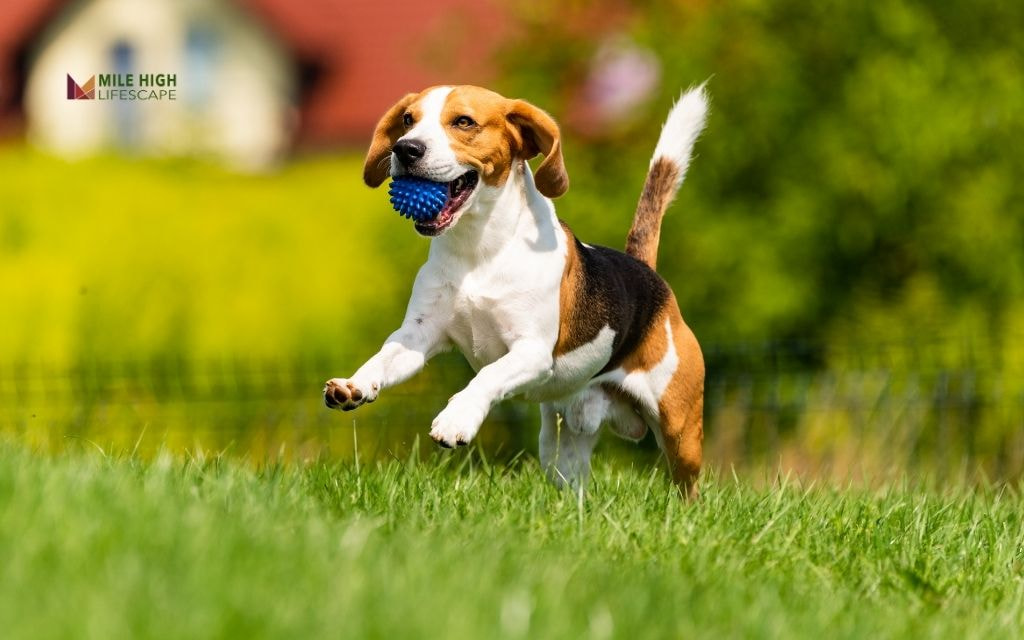
#3: Use Dog-Safe Deterrent Sprays
Commercial dog repellents featuring natural scents effectively discourage garden intrusions. Citrus, vinegar, and rosemary-based products create unpleasant associations without causing harm.
DIY solutions offer cost-effective alternatives. Diluted vinegar spray works well when applied regularly. Essential oil blends require careful research for pet safety. Always test small areas first and consult veterinarians about specific ingredients.
Important: Avoid pepper-based products in Denver’s dry air. These substances can cause respiratory irritation and eye discomfort.
#4: Plant Dog-Repelling Flowers and Herbs
Dogs typically avoid lavender, rosemary, marigolds, citronella, and rue. These plants release scents that discourage close investigation.
Companion planting integrates deterrent species with desired flowers. Marigolds protect vegetable gardens while adding vibrant color. Lavender creates fragrant borders that repel both dogs and many garden pests.
These plants require minimal water once established, fitting perfectly with Denver’s water conservation goals. Their drought tolerance makes them ideal for sustainable landscape design.
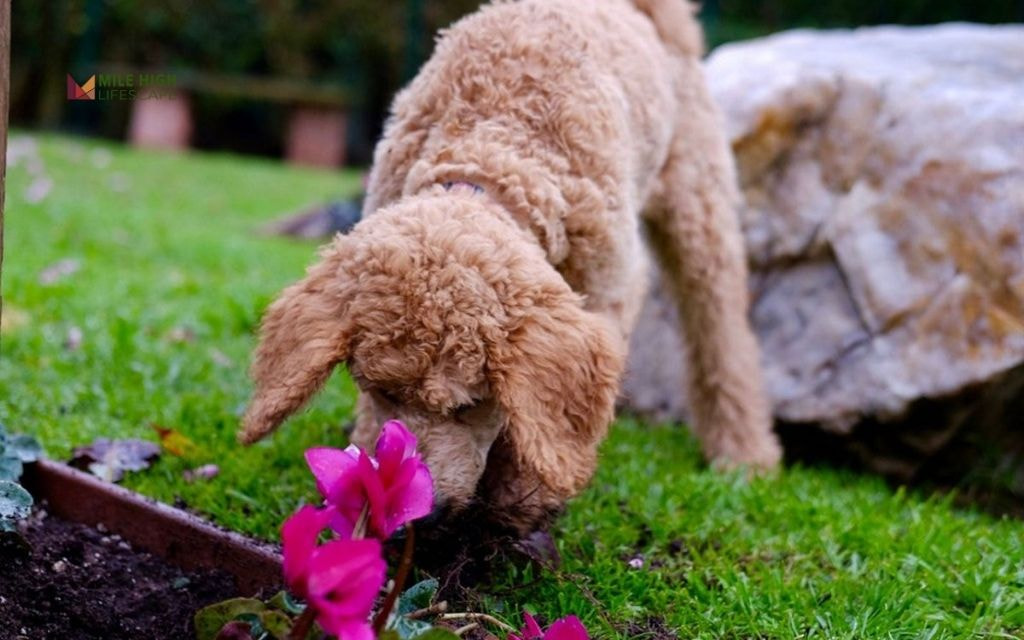
#5: Mulch Smartly to Deter Digging
Mulch selection significantly impacts dog behavior in flower beds. Coarse materials like pine cones, bark nuggets, and crushed stone create uncomfortable digging surfaces.
Dogs dislike unstable, irregular textures under their paws. Sharp-edged mulches discourage lying down in flower beds without causing injury. These materials also provide excellent plant protection and water retention.
Critical Warning: Never use cocoa mulch around dogs. This material contains theobromine, which proves toxic to canines. Choose pet-safe alternatives that provide equal benefits without health risks.
#6: Motion-Activated Solutions
Technology offers sophisticated deterrent options for persistent problems.
- Motion-activated sprinklers startle dogs without causing harm. These devices work particularly well for nighttime protection when supervision isn’t possible.
- Ultrasonic devices emit sounds humans can’t hear but dogs find unpleasant. Some devices may affect nearby pets beyond your property.
- Solar-powered units take advantage of Colorado’s abundant sunshine. These systems require no electrical connections and operate independently once installed. Battery backup ensures continuous protection during cloudy periods.
Position devices strategically to cover flower bed approaches without triggering false alarms from wildlife or passing pedestrians.
#7: Training & Positive Reinforcement
Consistent training creates lasting behavior changes that protect flower beds long-term.
Reward systems work better than punishment for most dogs. Offer treats immediately when pets avoid restricted areas or respond to redirection commands. This positive approach builds cooperation rather than fear.
Combine training with physical barriers for maximum effectiveness. Dogs learn faster when clear boundaries support verbal commands. Consistent enforcement prevents confusion and backsliding.
Professional dog trainers in Denver understand local challenges and breed-specific tendencies. Consider consultation for persistent problems or particularly determined diggers.
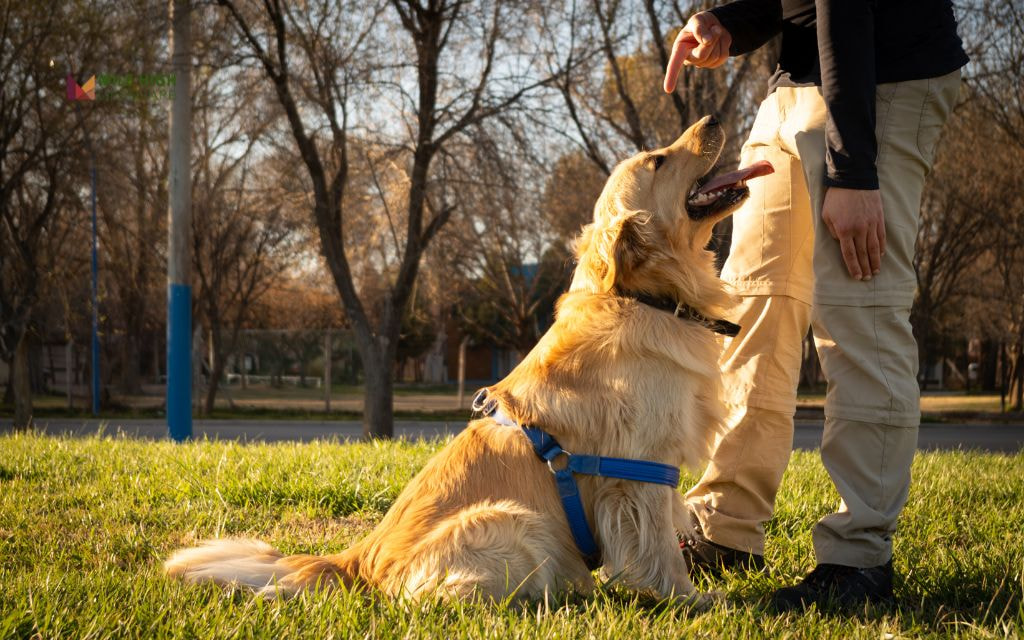
#8: Temporary Barriers During New Planting or Recovery
Fresh plantings need extra protection during vulnerable establishment periods. Collapsible pet pens provide adjustable coverage for different bed sizes and shapes.
Garden hoops with mesh create protective tunnels over seedling rows. These structures allow sunlight and water access while preventing pet damage. Remove barriers once plants develop strong root systems.
Chicken wire domes work well for individual plants or small clusters. These covers blend into garden aesthetics while providing complete protection. Choose galvanized materials for Denver’s UV exposure.
Common Mistakes to Avoid
- Harmful deterrents create more problems than solutions. Mothballs contain toxic chemicals dangerous to pets and children. Sharp objects like broken glass or pointed stakes risk serious injury. Chemical treatments may contaminate soil and groundwater.
- Punishment-based training often proves counterproductive. Yelling or physical corrections create stress without teaching appropriate behaviors. Fear-based approaches may worsen anxiety-driven digging or marking behaviors.
- Hoping pets “learn naturally” leads to frustration for both owners and animals. Dogs need clear guidance and consistent boundaries. Waiting for self-correction often results in established bad habits that become harder to break.
- Ignoring breed tendencies reduces solution effectiveness. Terriers dig instinctively and need stronger deterrents than gentler breeds. Retrievers respond well to redirection training, while hounds may require scent-based solutions.
Understanding individual dog personalities improves success rates significantly. Work with pets’ natural tendencies rather than against them.
Conclusion
Protecting flower beds requires a combination of prevention, training, and thoughtful design that considers both plant and pet needs. Denver’s unique climate makes this approach especially effective.
High-altitude gardening presents enough challenges without adding pet conflicts. Smart planning creates harmony between beautiful landscapes and beloved animals. Physical barriers, natural deterrents, and positive training work together for comprehensive protection.
Mile High Lifescape provides custom, pet-friendly flower bed services for Colorado homeowners who seek both beauty and functionality. Our experience with local conditions and pet behaviors ensures solutions that work long-term in Denver’s demanding environment.
Professional guidance helps avoid costly mistakes while creating gardens that satisfy everyone in the family – including four-legged members.
Frequently Asked Questions (FAQs)
How to stop a dog from digging in flower beds?
Yes, you can stop digging behavior through multiple approaches:
– Use physical barriers like low fencing or mesh covers over beds.
– Apply coarse mulch that feels uncomfortable to dig through.
– Provide alternative digging areas with loose soil or sand.
– Train with positive reinforcement, rewarding dogs for avoiding flower beds.
Will coffee grounds keep dogs out of flower beds?
No, coffee grounds don’t reliably deter dogs and may pose health risks. While some dogs dislike the smell, others ignore it completely. Used coffee grounds can be toxic to pets in large quantities due to caffeine content. Choose proven deterrents like citrus peels or commercial repellent sprays instead.
How to stop a dog from pooping in flower beds?
Yes, this behavior can be redirected effectively:
– Create designated bathroom areas with appropriate surfaces like gravel or mulch.
– Keep flower beds clean of any existing waste to remove scent markers.
– Use motion-activated sprinklers to startle dogs approaching restricted areas.
– Train with leash control and reward appropriate bathroom location choices.
How tall should a flower bed fence be to keep dogs out?
Most dogs are deterred by fences 18-24 inches high around flower beds. Small breeds need only 12-18 inches, while large dogs may require 24-30 inches. Consider your specific dog’s jumping ability and motivation level. Decorative fencing often works better than utilitarian barriers because it’s less likely to be challenged.
Will coffee grounds hurt my flowers?
Yes, coffee grounds can harm flowers when used improperly. Fresh grounds are acidic and may burn plant roots or create overly acidic soil conditions. Used grounds work better but still require composting before garden application. Coffee grounds also attract dogs in some cases, making them counterproductive for pet deterrence.
